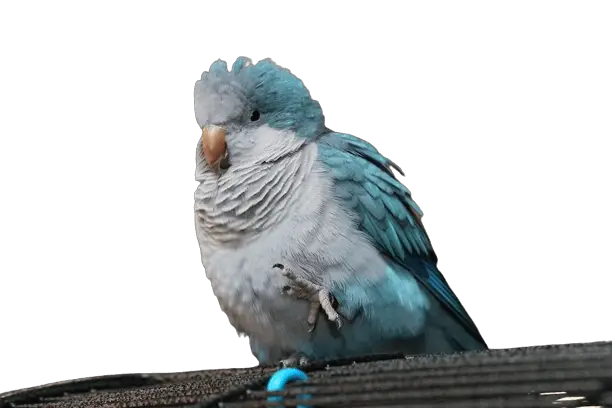
Blue Quaker Parrot (Monk Parakeet) Care Guide: Personality, Diet, Lifespan, and More
A blue Quaker parakeet (blue monk parakeet) is a funny and affectionate avian companion like all Quaker parrots.
Well, except for their obvious color due to years of selective breeding.
For such a small size, the blue Quaker parrot brings so much value with its exceptional ability to speak, low cost and availability.
Now, I’m sure you want to know a lot more about these cute little beasts.
Do not worry.
This guide will tell you everything you need to know about blue monk parrots, from their origin to their diet and cost, to their lifespan, and everything in between.
There are no significant differences between blue and green Quakers apart from color, but I will spot places where there might be any throughout the article.
Alias of the blue Quaker parrot
To avoid confusion and get acquainted with blue Quaker parrots, you need to know their other names.
Here are the aliases of the blue Quaker parrot:
- Blue Quaker Parakeet
- Blue monk parakeet
- Blue monk parakeet
- Blue parakeet
- Grey-breasted parakeet
- Montevideo parakeet
Blue Quaker Parakeets Bio Data
Generally, wild monk parakeets are native to South America in countries like Bolivia, Argentina, Brazil, and Paraguay.
Monk parakeets inhabit the temperate and subtropical regions of these countries. In addition, being an open forest species, they adapt well to urban areas and cold climates.
As a result, some autonomous wild colonies were introduced into the United States as far north as New York and parts of Europe and Asia.
Unfortunately, it is illegal to own or sell a Quaker parakeet in some states because of the potential danger it poses to locally produced crops in those (mostly rural) states. Simply put, they are considered major agricultural pests and not pets.
Scientific information
The blue Quaker is just a variation of the color of other Quaker parrots, and they all have the same scientific name – Myiopsitta Monachus.
All subspecies have distinct color markings, geographic location, and size
The size and appearance of the blue Quaker parakeet
The blue Quaker parakeet is relatively small. They measure about 11 inches from beak to tail.
An adult weighs on average about 3.5 ounces (100 grams). Most of the time, they do not reach this size, not even green Quakers, slightly larger. But adults in the wild can reach up to 4.4 to 4.9 ounces (127-140 grams).
The plumage of a blue Quaker is unique and easy to discern from other breeds. It has light blue upper parts (back and wings) that extend to its long, tapered tail. Then he has a bluish-gray chest that is the same tone as his forehead and lower wings. Its beak is orange-yellow and has a white eye ring with black eyes.
As a monomorphic species, the identification of male and female Quakers can only be done reliably through DNA or feather analysis.
However, females tend to be about 10-20% smaller, but you can’t always rely on this for accurate identification of the Quaker’s gender.

Ability to speak blue Quaker
Blue Quakers are talkative and will learn words soon after they arrive in a new home (a day or two if they are old enough). Although they are not able to assemble an extensive vocabulary like green Quakers, they can still speak like crazy.
For example, Smooches, a green Quaker would say “we go baby bye” or “can we go to bed” if he is tired of perching and wants to go to his cage.
The good news is that blue Quaker parrots are also able to speak this way, but with fewer words or phrases:
Sound level
A blue Quaker can increase the sound level at any time it feels like it. Typically, he could go after a long time with repetitive shrill screams and howls.
In any case, one might hope that this stops while he feeds, but this is not the case. Blue Quakers and Quakers, in general, make noisy chatter while feeding.
On the positive side, they tend to make noise only if someone or an animal approaches their cage. This makes your blue monk parrot a dual bird alarm system.
Blue Quaker parrot Personality
The small blue Quaker parrot is comical and has a very large personality for a bird of its size. With such a big heart, it does not tend to be a solitary bird and will bond with several people if given the opportunity.
This kind of personality makes it a good family pet.
However, if I were you, I would take this path with caution. As big as his heart may be, he is also very bold, so he forgets his small size for larger creatures.
As a result, he may try to impose himself on children or even adults by biting them. If you have children, there are more suitable parrots that you should consider for your home.
Similarly, a blue Quaker can become very defensive and possessive of its cage and has been known to attack or even kill the intruder. What this means is that you should not pair your blue Quaker with another bird unless it is another Quaker. Even then, you will have to separate their cages at the beginning for them to bind.
Unlike other species of parrots, blue monks will maintain their bond with their owners and feathered companions.
On the other hand, a blue Quaker is a playful and energetic bird to keep as an avian companion. For this reason, they need a lot of toys in and out of their cage.
Even though you need to be prepared to replace chew toys more often, as they can be quite destructive to them. Then mix things up with puzzle toys and rotate them regularly, so your feathered friend doesn’t get bored (and they do it easily).
If you wish, you can bring out the handyman from your blue Quaker by providing him with nesting materials in your home.
Proper care for your blue monk parakeet and potential health problems
Accommodation
These birds will live comfortably in an ambient temperature of 60-80 degrees Fahrenheit. In the wild, the blue quaker parrot is able to adapt to harsh climatic conditions.
A Quaker bird cage must have a minimum size of 24x24x24 with a bar spacing of 5/8 to 3/4 of an inch. But if you can afford to buy a larger cage, you should opt for the larger one available. It will provide enough room for perches and toys to keep your bird supple.
That being said, you need to rotate the toys regularly to prevent the bird from getting bored. Boredom can lead to the uprooting of feathers and self-harm.
Also, try to install perches of different sizes to keep its legs agile. The installation of cement perches can eliminate the need to cut the nails. If the need arises, I advise you first to consult a veterinarian.
Diet
Blue Quakers Parrot needs a balanced diet that mimics their foods in the wild to stay healthy and strong. This includes
- Seeds
- Fruits
- Vegetables
- Insects
- Nuts
- Berries
Oh, and they love chili peppers too!
It is best to start with granules for overall nutrition and mix with seeds later.
The thing is, seeds and pellets can lead to fatty liver disease and sometimes cause your bird to gain weight. To avoid this, always supplement your Quaker’s diet with plenty of fresh vegetables.
Check out this list of nutritious and toxic foods for your blue Quaker.
Hygiene
That’s pretty much a no-brainer. You need to keep your Quaker itself, and its environment always clean.
Give him a bath every other day in a shallow basin or by misting him with a spray bottle if he does not enter the bath.
Also important, clean the cage daily from droppings and leftovers to avoid harmful infections. If you give fresh vegetables to your blue Quaker, get rid of them after a few hours, even if he hasn’t taken a bite.
Breeding
Blue Quakers are quite easy to breed, and unlike many other parrots, they will build their nests. It is recommended to provide nest boxes instead to facilitate access to chicks without destroying the structure.
Parents could desert their chicks if they disturb the structure of the nest they have built.
Their breeding period is between October and December. In one clutch, you can expect about 4-12 eggs with a good chance that they will all hatch in 24 days.
Exercise
As you already know, you need to provide a lot of toys to keep your blue Quaker not only happy but also fit. A playroom is another way to help your pet burn some fat.
How long does a blue Quaker parrot live?
A blue Quaker has an average lifespan of 15 to 25 years. But with proper care, he can live up to 25 or even 30 years.
How much does a blue Quaker cost?
A blue Quaker costs an average of $400 depending on where you buy it. The main costs to consider are expenses related to maintenance, feeding, and occasional visits to the veterinarian.
Should I take a blue Quaker?
If Quakers are allowed in your area, I see no reason not to. Unless you can’t afford to replace their worn toys or put up with the fact that they are usually not very nice to children.
Otherwise, a blue Quaker will make a charming avian companion for many years.
About Blue Monk Parakeet
SOURCE:Quaker Parrot and Lovebirds




















